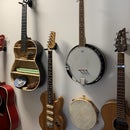Introduction: Stomp Box From Speaker - Super Easy 1 Hour Project
Stomp boxes have taken a massive sweep across pubs and bars as solo artist guitar players begin to realise that they can get a cool sound out of that naturally stomping foot that they have.
Here is how to do it really fast, really easily and get awesome results.
(When I watch the video, I'm not really impressed, but when I heard the stomp box I was, the camera does not have very good sound quality).
Essentially it works like this, take a speaker, put it in a box and wire it to a jack.
I'm going to show you how to convert this speaker that I found in a pile of rubbish outside my neighbours into a functioning kick box using only one extra part.
Parts:
An old speaker
1/4 inch Mono Jack Female
(available at radioshack, or if you are from New Zealand like I am, Jaycar, but they are super easy to find anywhere.)
Tools:
Saw
Screw drivers
Drill
Drill bit that matches your jack size (they do vary a little)
Wood glue
Soldiering iron
Soldier
Attachments
Step 1: Disassemble the Speaker
First note, they say there is more than one way skin a cat. I personally haven't tried skinning a cat, but there is definitely more than one way to do this part.
You have a choice at this point. You can take the front cover off the speaker and replace it with a piece of wood to stomp on, which will save you some work, or you can disassemble it and use the back of the speaker as the stomp box. You could even build an entirely new box out of nicer wood and smash the crap out of the old one so that you can easily access the speaker.
The reason I chose my solution is because it was quick, easy and it looks tidy in the end.
I took the front off the speaker. Check for screws first, because some will come apart with some screws, but this one was pinned and glued. If you make a mess of the front of the speaker, it's not going to be a big deal, in fact, you could saw it in half like in step 2 and save some work, but you are playing some guessing games there.
I pried mine apart with a screwdriver being careful to keen the box in good shape.
I then unscrewed the main bass speaker and snipped the connections to the tweeter. You could save use the tweeter and have a two tone stomp box that sounds different if you hit in different areas, you could also wire a potentiometer between them that decides how much of each was in the mix, but I decided I was happy with the one sound (and I broke the piezo trying to pry it free).
Step 2: Working on the Box
Once you have your speaker out you will see how easy the next piece might be. Some speakers have metal brackets that make it sit back from the mount and some have metal brackets that make it sit forward.
Mine sat forward, so there was parts of the speaker that would touch the box if I were to try screw it on directly. This meant that I had to use something to create some space between the box and the metal speaker mount.
The front of the box worked perfectly for this as it already was designed to mount the speaker. I just had to do a couple of modifications to get it to fit inside.
Once I had this sorted, I measured the distance from the back of the speaker to the back of the box and gave it a little room for error and also room for me to put a back on if I wanted to.
I then cut the speaker box down to the size that I wanted.
I found the right size drill bit for the jack that I had and drilled through the box.
My box was too thick, so I cut a slot on the inside of the box so that the nut could fit on the jack once it was put through the hole. I did this using a craft knife and it was easy for me because my speaker was made of particle board. If your speaker box is made of better wood, you may need to use a chisel, dremel or get creative to figure out a solution.
I then blew out the dust, peeled the laminate off the speaker mount and glued it into the box.
Step 3: Soldiering the Jack.
For people who are electronic and intractable pros and are cringing at the thought of this project already being over, you can go get some capacitors, resistors and potentiometers and design up a volume and an equaliser like this one to add to your stomp box. You can put in a couple of piezo pickups to add some flavour. I'm probably going to do that with my next one, but I wanted to do this for the concept.
If you don't know how to soldier, this is a real easy place to start. For this project you are only soldiering two small pieces. My advice for buying a soldering iron is to get a decent one from an electronics shop and not a cheap one from a hardware store. The cheap ones burn out really quick. If they have a return policy, keep the receipt.
The trick is to wait until the soldiering iron is up to full heat. Cut your wires to the right length and strip them down to the copper or wire. Twist the ends to make them stay together and push them through the holes in the jack where they need to go. The red wire (wire with a white stripe or wire coming from the + on the speaker) connects to the tip of the plug, so it goes piece connected to the long part of the jack. The black wire goes to the base of the plug and so it goes to the part that connects to the inside of the hole.
Once you have put the wires in place, bend them over or wrap them around so that they don't fall out when you are trying to soldier. Cover the parts you want to soldier in flux. This makes it really easy. Rest the jack in a place where it won't roll about and it is easy to access with the soldiering iron. Put the soldiering iron where you want the connection to be made and push the soldier against the side.
If you still can't get it, don't panic, you are on instructables and there are plenty of lessons on how to soldier!
Once you are done, put the jack in the hole you drilled, screw the nut on to hold it in place and you have completed your stomp box!
Plug it in to a guitar amp or mixing desk and stomp away!

Participated in the
DIY Audio and Music Contest

Participated in the
Guerilla Design Contest














